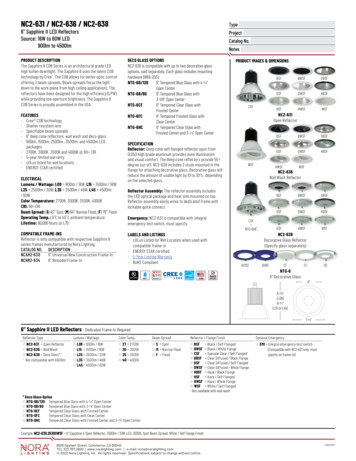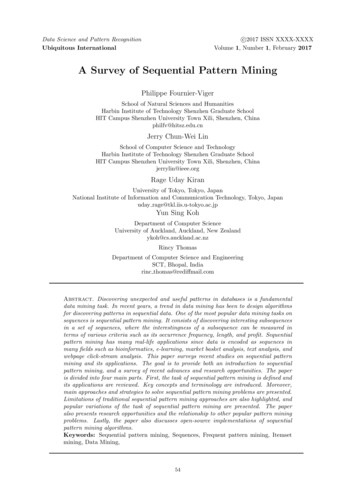
Transcription
Sapphire rush near Kataragama1NEWS FROM RESEARCHTHE REPORT INDICATES THE STATUS OF A RESEARCH PROJECT THAT IS STILL ONGOING WITHIN GIA LABORATORYBANGKOK. COMMENTS ON THIS AND OTHER REPORTS AND THEIR DIRECTION ARE WARMLY WELCOMED AS ARE OFFERS OFCOLLABORATION. PLEASE CONTACT: INFO@GIATHAI.NET STATING THE NAME OF THE PROJECT AND NAME(S) OF THEAUTHOR(S).SAPPHIRE RUSH NEAR KATARAGAMA,SRI LANKA(FEBRUARY – MARCH 2012)Vincent Pardieu, Supervisor of Field Gemology, GIA Bangkok; Emily V. Dubinsky,MS, Research Associate, GIA New York; Supharart Sangsawong, PhD, ResearchAssociate, GIA Bangkok; and Boris Chauviré, Geology Msc. Degree Student,Nantes University, FranceFigure 1: A fine blue sapphire crystalPhoto: V. Pardieu / GIA Laboratory Bangkok. /research-resources/news-from-researchSriLanka.May 2, 2012
Sapphire rush near Kataragama2TABLE OF CONTENTS:ABSTRACT . 3INTRODUCTION: . 3SAPPHIRE MINING AROUND KATARAGAMA – TISSAMAHARAMA BEFORE THE FEB.2012 DISCOVERY: . 8THE FEBRUARY 2012 DISCOVERY NEAR KATARAGAMA – TISSAMAHARAMA: . 9The GIA Field Expedition (FE33): . 17Visits at the Mining site: . 18Witnessing the sapphire trade around Kataragama: . 25Geology of the new sapphire deposit near Kataragama: . 29Field and Market Observations of Rough Crystals Seen Around Kataragama: . 38SAPPHIRES FROM KATARAGAMA: A PRELIMINARY DESCRIPTION. . 45Materials and methods . 45Brief description of the reference samples selected and studied: . 46Specimen 100305162359. 47Specimen 100305162360. 52Specimen 100305161800. 57Specimen 100305161771. 60Specimen 100305161828. 62The internal world of Kataragama sapphires . 65Special Thanks: . 80Annex A: Content from the National Gem & Jewellery Authority website published onMarch 1, 2012 . 81Annex B: Interview in the Sunday Leader; Published March 4, 2012 . 81Annex C: GIA Field Gemology cataloguing System: . 81References: . 82 -researchMay 2, 2012
Sapphire rush near Kataragama3ABSTRACTIn February 2012 a new sapphire deposit was discovered at a road construction sitenear the town of Kataragama, situated in the Monaragala District of Uva Province, SriLanka. The area has been known as a sapphire-producing area since the end of the1970s (Zwaan, 1981). The Sri Lankan authorities were swift to react when news ofthe find broke, and after a brief gem rush the deposit was secured and an auctionover the mining rights was organized by the National Gem & Jewellery Authority(NGJA). Official mining activity commenced in March 2012.In collaboration with the NGJA, GIA organized two field expeditions to the areaimmediately upon learning of the discovery, in order to observe the rapidly evolvingmining developments in the area and to collect samples for laboratory analysis andcharacterization.Field observations of mining activity detailed in this report describe the sapphiremining and trading situation at the mining site, and present some information aboutthe geology of the area and a description of the sapphires observed during theexpedition.It is believed that the deposit may be a primary deposit associated with a residualone, although this has not yet been confirmed.The sapphires found thus far are fine, unworn crystals or crystal fragments of notablylarge size, with fine blue color typically confined to a narrow rim around the surface.Particulate bands, negative crystals, healed and unhealed fissures, and crystalinclusions such as graphite, mica, and spinel are typical internal features.Rough crystals analyzed in the GIA Laboratory show moderate iron contents that areslightly higher than those typically observed in Sri Lankan sapphires from otherdeposits.INTRODUCTION:On February 23, 2012, Shamil and Armil Sammoon from Sapphire Cutters Ltd.(Colombo, Sri Lanka) informed GIA’s Bangkok Laboratory about a new find of bluesapphires located on the southeastern coast of Sri Lanka between Kataragama andTissamaharama near the world-famous Yala National Park, one of Sri Lanka’s majorareas dedicated to conservation and tourism.Yala hosts one of the world’s highest concentrations of leopards, along withnumerous deer, elephants, and a variety of birds including stunning peafowls, whoseblue-colored feathers are a difficult challenge to match even for the best Sri Lankanblue sapphires.Besides being one of the major tourist destinations in Sri Lanka due to theneighboring Yala National Park, the region has also been a very famous traditionalHindu and Buddhist pilgrimage center for many centuries, attracting thousands ofpilgrims on weekends and holidays. -researchMay 2, 2012
Sapphire rush near Kataragama4Figure 2: Peafowls from Sri Lanka and particularly from Yala are known for the beauty of their blue feathers. Photo:V. Pardieu / GIA Laboratory Bangkok.Blue sapphires are not really something new in Kataragama: Since the end of the1970s, blue sapphires have been found near Kataragama (Zwaan, 1982). They werediscovered near Amaraweva, about 10 km from Tissamaharama in the direction ofKataragama and at Kochipadana about 5 km east of Kataragama in the direction ofYala National Park.According to Zwaan (Zwaan, 1981; Zwaan, 1982; Zwaan, 1986) at that time thesapphires were found in secondary deposits. Usually the stones were well-developedcrystals with much less evidence of transport than other sapphires found elsewhere -researchMay 2, 2012
Sapphire rush near Kataragama5in Sri Lanka. Consequently Zwaan believed that the primary was not located very faraway, but he could not find it.In 2012 nevertheless the rumor was that the new deposit was producing some largeand very beautiful sapphire crystal specimens in qualities never seen before in theregion and possibly on the whole island (see Annex B). This new discovery created atremendous interest among Sri Lankan miners and traders, and also among theisland media and public as many people believed that stunning stones would beproduced from that new find.That new deposit was seen as very good news by the Sri Lankan trade, becausesince the royal wedding of Prince William with Kate Middleton the demand for fine SriLankan sapphires has been very high.The beautiful aspect of the sapphire crystals produced also raised the interest ofgemologists and geologists about the nature of the deposit. The stones were indeedremarkable euhedral crystals specimens presenting no indication of weathering,indicating that they were probably coming from a primary-type deposit. Primarysapphire deposits are known in Sri Lanka near Avisawella, Bakamuna, Wellawaya,and Kolonne, but except for Avisawella (to some extent) they are not known toproduce truly gem-quality material. The discovery of a primary-type sapphire depositproducing gem-quality sapphire would be quite noteworthy and interesting for thescientific community, and would finally confirm Zwaan’s observations.Figure 3: Pagoda surrounded by paddy fields, a common sight near Kataragama. Photo: V. Pardieu / GIA LaboratoryBangkok. -researchMay 2, 2012
Sapphire rush near Kataragama6Figure 4: Simplified geological map of Sri Lanka with its main sapphire deposits. Map courtesy R.W. Hughes /Sapphminco, 2012. -researchMay 2, 2012
Sapphire rush near Kataragama7Figure 5: This Google Earth map shows the location of the new sapphire deposits (in red and yellow) recentlydiscovered near Kataragama. The location of the other deposit in the area that has been known since the end of the1970s is shown in white. -researchMay 2, 2012
Sapphire rush near Kataragama8SAPPHIRE MINING AROUND KATARAGAMA –TISSAMAHARAMA BEFORE THE FEB. 2012 DISCOVERY:Several studies of sapphires from the Kataragama – Tissamaharama area can befound in the gemological literature from the past 30 years (Zwaan, 1981; Zwaan,1982; Zwaan, 1986; De Maesschalk, 1989; Hughes, 1997). Besides blue and yellowsapphires, Zwaan noted that the secondary deposits in the region also producegreenish blue spinels, garnets, zircons, tourmaline, beryl, scapolite, quartz, apatite,diopside, actinolite, sphene, and spodumene.Figure 6: Local people mining sapphire near Ittagama in 2010 using a dry sieve technique. Photo: V.Pardieu / GIALaboratory Bangkok.In 2011 author VP visited the area while on a field expedition around Sri Lanka tocollect sapphire reference samples for the GIA Laboratory Bangkok. During thatexpedition we witnessed some very low-scale sapphire mining. Local people mainlyperformed it illegally on land belonging to the Sri Lankan Forest ConservationDepartment.In a forest-covered area near Kochipadana we met a group of five miners who firstfled when the author and his team arrived on site, fearing them to be rangers fromthe Forest Conservation Department. Upon their return the author was able to studytheir production (Figure 7).At Ittagama, an area close to Amarawewa, we met another small group of two miners(Figure 6) working the gem-rich soil using hand tools and some dry techniques toseparate the sapphires from the reddish sapphire-rich ground. The gem mining sitesvisited were both secondary, residual-type deposits. The local miners were onlyinterested by sapphires and were not collecting other minerals. -researchMay 2, 2012
Sapphire rush near Kataragama9The author did not observe gem-quality material from the few stones presented bythe miners, but the low-quality sapphires seen from their production were found to bevery similar to the stones studied and described by Zwaan in the 1980s.Figure 7: Yellow and blue low-quality sapphires seen from a miner working at Kochipadana in 2010. Photo: V.Pardieu / GIA Laboratory Bangkok.THE FEBRUARY 2012 DISCOVERY NEAR KATARAGAMA –TISSAMAHARAMA:According to the information gathered from the National Gem & Jewellery Authority(NGJA; see annex A), the deposit was discovered on February 15, 2012. However,some local people interviewed during the GIA Laboratory Bangkok field expedition toKataragama reported that the deposit was first discovered as early as February 10,2012, by workers on a road construction site between Kataragama andLunuganwehera (located at 06 21’54"N, 81 16’20"E; see Figure 5).As is commonly the case in most gem rushes, rumors are plentiful and it issometimes difficult to separate fact from fiction. While visiting the mining siteprepared by the NGJA, the road construction site where the discovery was made,and also the homes of many locals in the Kataragama area, the authors asked anumber of people to describe their version about what happened in Kataragama. Inresponse to their inquiries they received a variety of stories. To provide to the readeras much information as possible about the atmosphere around Kataragama duringthe GIA expedition, we chose to integrate some of these stories into the report—evenif we could not confirm them—as they are quite useful to providing a picture of thesituation at the time of our visit around Kataragama (see Box C: Rumors and secretsaround Kataragama).Most people agree that the new deposit was discovered on February 13, 2012, but arumor persists that the discovery was made on February 10 by some workers whilespreading some ground on the road construction site. In this version, during one -researchMay 2, 2012
Sapphire rush near Kataragama10dumping of a truck-load of earthen soil, the road suddenly became blue withhundreds of sapphire crystals. One or two construction workers (from Ratnapuraand/or Kandy) filled their helmets with several kilos these fine sapphire crystals andthen disappeared with their treasure. According to the rumor for three days thediscovery remained quite confidential, until a brief rainfall that occurred on February13, 2012. Thanks to the rain that washed away the dust, for a few hours bluesapphire crystals became easy to spot on the wet road construction site. Peoplestarted to find blue gems and called for support from relatives and friends. Within afew hours an all-out rush ensued. It started with children and women from theneighboring villages coming with all the tools they could gather from their homes tofirst collect the stones, when the ground was still wet, and then the gem-rich soilwhen it became dry again. Thanks to cell phones, the news of the discovery spreadlike brush fire, and within hours thousands of people descended upon the discoveryarea.On February 14, 2012, between 10,000 and 30,000 people were reportedly busymining on the road construction site. Eranga Basnayake, a Balangoda-based SriLankan gem miner and merchant, took the photographs shown in Figures 8 and 9 onthat day as he rushed to Kataragama.Figure 8: Local people rushed to the road construction site near Kataragama on Feb 14, 2012. A frenzied miningeffort using hand tools or even bare hands soon commenced. Photos: Eranga Basnayake. -researchMay 2, 2012
Sapphire rush near Kataragama11Figure 9: Local people taking away potentially gem-rich soil from the discovery site near Kataragama. Photo: ErangaBasnayake.On the afternoon of February 14, 2012, the Sri Lankan police reportedly moved in tochase away the illegal miners and secure the construction site. While conversing withlocals near the mining site, we were told the same story and some rumors about thatevent by a number of different people. All of them reported that on the evening ofFebruary 14 the police asked everyone to return home and remain indoors. Thenduring the entire night the local people said that they heard trucks going back andforth from the discovery site. Many locals suspect that the police, the army, or someother powerful group collected many truckloads of gem-rich soil during that time,possibly replacing the gem-rich ground with common soil. The authors could notconfirm such rumors but heard them from many sources.After control of the discovery site was secured by the police, the NGJA was officiallyinformed on February 15. The organization moved swiftly: The NGJA first visited thediscovery site on February 17. They found out that the soil being used in theconstruction project had been supplied from a small peanut and chili farm locatednearby (06 22'16"N, 81 17'18"E) that belonged to a private owner named Mr. Ranga. -researchMay 2, 2012
Sapphire rush near Kataragama12Figure 10: In March 2012, Sri Lankan police controlled access to the mining site near the road construction sitelocated on the right side of the road just beyond the hill shown here. Photo: V. Pardieu / GIA Laboratory Bangkok.Figure 11: The road construction site where the discovery was first made, as seen on March 8, 2012. Photo:V.Pardieu / GIA Laboratory Bangkok. -researchMay 2, 2012
Sapphire rush near Kataragama13Figure 12: Mr. Ranga, the lucky 23-year-old Sri Lankan farmer who owns the farm where the sapphire discovery wasbelieved to have been made. Photo: V. Pardieu / GIA Laboratory Bangkok. -researchMay 2, 2012
Sapphire rush near Kataragama14Box A: Mr. Ranga’s story about the new sapphire discovery nearKataragamaUntil a few weeks ago, Mr. Ranga was simply a young farmer working on asmall farm producing chili, onions, tomatoes, and peanuts. He had a projectto build a new house on his farm, which had a small hill on it and was locatednear the road construction project between Kataragama andLunugamwehera. He learned that one of the contractors building the roadwas searching for sand and soil to spread on the road construction site. Hevolunteered to sell the ground from the hill on his land for 100 rupees (a littlebit less than US 1) per tractor load. The contractor refused and proposedhim 50 rupees per load. They agreed on that price and over the course ofthree months the contractor collected a just over 1000 loads from Mr.Ranga’s land. During that period, he checked every load of his land as it wasremoved and thus had a very precise knowledge of where his land wascollected and on what part of the road it was subsequently spread on.According to Mr. Ranga on February 13 a small rain had fallen in the area.Some little boys from the nearby village began to find blue stones on the wetroad. Soon, many people from the nearby village (mainly women) and furtheraway started to come to the road construction site to collect gems. The newsabout the discovery spread rapidly and soon a kilometer-long stretch of theroad construction site was full of people. Mr. Ranga estimated that morethan 40,000 people were in the area, either searching for gems or sellingwater and food to the diggers.The people from the area had no knowledge about the stones and for thefirst few days mining occurred only along the road construction site. After thisperiod some more experienced people inquired about the source of the soilthat had been spread on the road. Mr. Ranga reported to the authorities thatthe earh had come from his farm. The area was then secured and sectionedoff into 50 lots by the NGJA, of which 49 were auctioned on February 24,2012 in Kataragama.Mr. Ranga told us that he had sold his farm and his house to one of thepeople who had come to mine the area for US 100,000 plus a miningpartnership agreement. He said that he is now living in his mother’s house.When the author asked him if he had collected some nice big blue sapphirecrystals himself on the road, he had said that sadly he had not been luckyabout that and was only able to collect some small samples that he hadquickly sold. When asked if he still had any samples, he answered that heonly had a few low-quality stones. The author was able to buy these from Mr.Ranga as reference samples for the GIA reference collection (D3 typesamples, according to the GIA field gemology cataloguing system; seeAnnex C for more details). He also added that he was in fact verydisappointed not to have been able to find any big stones on the road likesome of the other people who went there, but he is still hoping that whenthey mine the land under his house in the future, they will discover many biggems. -researchMay 2, 2012
Sapphire rush near Kataragama15The NGJA then had some discussion with the Forest Conservation Department,which owns the land in that area. They quickly came to an agreement to deal with theissue in order to ease the pressure from the numerous people anxious to mine thearea. The ownership of 3.5 acres of land around Mr. Ranga’s farm (where thesource of the sapphires was believed to be located after an on-site visit by expertsfrom the NGJA), was transferred from the Forest Conservation Department to theNGJA. That land was further dived into 50 mining lots (see Figure 13). The size ofthe mining lots was typically very small (about ten meters by ten meters), enablingonly gem mining at the surface with hand tools. The NGJA organized an auction onFebruary 24 in Kataragama offering one-year mining rights on 49 of these lots. Theauction brought in a record 271 million rupees (about US 2.5 million) in revenue forthe NGJA despite the fact that the mining rights were given for only a year. Obviouslythe promising aspect of the nice-looking, large-size sapphire crystals found on theroad construction site generated a great deal of interest and confidence in futureprospects.Figure 13. Authorities divided the land surrounding the new Kataragama sapphire deposit into the 50 mining lotsshown in this survey. These lots were auctioned on February 24, 2012. Photo: V. Pardieu / GIA Laboratory Bangkok.The news of the discovery and the record-breaking auction were widely reported inthe local Sri Lanka media. The remaining lot (number 50 on the map Figure 13), wasassigned to a special mining project for the benefit of low-income residents of thearea. According to the NGJA chairman, 40% of the proceeds will be distributed to thelandowners.The miners were allowed to move on their lots contingent upon payment of their bidsby February 28, 2012, but most of them arrived on February 29 or March 1 at thesame time as the field gemologists from the GIA Laboratory Bangkok expedition. -researchMay 2, 2012
Sapphire rush near Kataragama16Figure 14: NGJA official delivering on site a mining license on March 1st 2012. Photo: Andrea Heather Go.Immediately in most mining lots small religious ceremonies were organized in orderto please the local spirits and bring good luck to the miners. At the same time,access to the mining lots and the miners’ camps were prepared.Figure 15: A small shrine is left after the religious ceremony marking the opening of the mining site. Heavy machineryused to build access to the different mining lots is shown in the background. Photo: V. Pardieu / GIA LaboratoryBangkok. -researchMay 2, 2012
Sapphire rush near Kataragama17Figure 16: On March 1, 2012, the mining site is prepared by the NGJA. Photo: Andrea Heather Go.THE GIA FIELD EXPEDITION (FE33):Upon news of the discovery on February 23, 2012, a field expedition to the area wasimmediately organized by the GIA Laboratory Bangkok. Our objectives were to studythe new deposit and obtain material for preliminary examination and characterizationin the laboratory in order to be able to update the GIA’s Origin Specific CorundumDatabase.On February 28, 2012, a GIA Laboratory Bangkok team led by GIA Field GemologistVincent Pardieu with the support of gemologists Lou Pierre Bryl (F.G.A., Canada)and Andrea Heather Go (G.G., Canada) arrived in Colombo to visit the new area.Geologist and gemologist Boris Chauviré, at the time working in the field in Vietnamon blue spinel for his master’s degree in Geology in collaboration with author VincentPardieu, joined the expedition on March 6, 2012, for a second visit to the new depositnear Kataragama.On February 29, the GIA team met with NGJA officials, who arranged a specialpermit to visit the new mining area and provided contacts for several local NGJAofficials and some miners. It was agreed that the GIA would share the researchresults with the NGJA.On March 1, the GIA team reached the mining area after a 5-hour drive fromColombo.During the first three-day-long visit (March 1-3) and then from March 7-8, 2012,author VP and his team conducted daily visits to the mining site with the support ofofficials from the NGJA. On these visits we usually followed sapphire “hunters” goingfrom house to house to see if there were any stones worth buying. -researchMay 2, 2012
Sapphire rush near Kataragama18VISITS AT THE MINING SITE:During our regular visits to the mining site managed by the NGJA, we observed thatthe 3.5 acre area located at 06 22'16"N, 81 17'18"E, was being prepared to host anestimated 500 miners. The different mining lots had been well defined. The miningsite was quiet and the whole installation appeared to have been well managed by theNGJA and the police. Within hours the miners started to arrive at their claims, andcamps quickly sprung up on the recently cleared land.Meetings were regularly held between officials of the NGJA and the miners to speakabout mining, but they also addressed logistical issues like the use of machinery orsanitation. We witnessed several officials and media representatives visiting themining site while machinery was being used to build the access to the different lotsaccording to the map (Figure 13).Miners began work immediately upon arrival, loading the potentially sapphire-rich soilinto bags to be taken away for washing. The area is very dry and thus does notenable to miners to wash the potentially sapphire-rich soil covering their mining lot onsite. The fact that washing was performed up to several kilometers away from themining site did not permit the authors to see whether there was any production fromparticular mining operations.We were welcomed by the miners, who were very pleased to invite us to visit theiroperations. It was remarkable to find out that few of them had any knowledge orunderstanding of the geology specific to the mining site. Most of them were hereobviously trying their luck.Figure 17: View of the mining site with lots defined by simple ropes as we saw it upon our arrival on March 1, 2012.Note the large rocks on the right; these were reportedly placed here to secure one of the areas believed to be amongthe best and to prevent unauthorized digging. Photo: Andrea Heather Go. -researchMay 2, 2012
Sapphire rush near Kataragama19Figure 18: An NGJA official is shown meeting miners on March 1 at the mining site. We witnessed such meetingsregularly during the next days. Photo: Andrea Heather GoBox B: An aside about mechanized mining versus gemmining using only hand tools in Sri LankaDuring the FE24 expedition to Sri Lanka in March 2010, authorVP and his team witnessed numerous gem mining operationsacross Sri Lanka using excavators and machinery (GNI 2010).Nevertheless, the use of heavy machinery was an issue in SriLanka and in June 2011 the NGJA stopped issuing licenses formechanized mining. When author VP visited Sri Lanka again inJanuary 2011, mechanized mining was much less common andmany gem miners were quite unhappy about that. AtKataragama from March 1-6, 2012, only hand tools were allowedat the mining site. Some excavators were visible but they wereused only to build access to the different lots and not for mininggems. However, the miners encountered problems with hardrock, and on March 07 during a meeting between the miners andMr. W.H.M. Nimal Bandara, Director General of the NGJA, wewitnessed an announcement that the NGJA would allow the useof excavators to remove heavy rocks that were problematic forthe miners.On April 3, 2012, we learned from a Sri Lankan gem merchantvisiting Bangkok that the NGJA decided the week before toreissue licenses for miners permitting them to use machineryunder certain conditions while mining for gemstones in Sri Lanka. -researchMay 2, 2012
Sapphire rush near Kataragama20Box C: Rumors and secrets around KataragamaIn most gem rushes, rumor is an essential ingredient of the frenzysurrounding the discovery of new gem deposits. Speaking with differentlocal people and with the Sri Lankan gem merchants and miners fromall around the country who came in Kataragama, the author heardmany of these stories and rumors. It was very difficult to separate factfrom rumor.Mr. Ranga himself was very keen to tell us about two stories: The firstwas that when the earliest miners came to his land they saw a hugesnake. According to him, the animal was a gigantic white cobra thatcame out from a hole at the location where he believed the sapphirerich soil had been taken to be spread on the road. Sadly the snake waskilled, but Mr. Ranga believes that this snake was a kind of spirit thatwas showing them where the best stones were located. That same lot,lot number 2, is about 10 meters by 10 meters; it was later auctionedfor a record-breaking amount of US 200,000 for one-year miningrights.We also heard another story about a monk who had lived in the nearbytemple. That old monk, who has passed away a few years ago, used tosay that in the area was a hidden “blue flower palace” (“Nilmatalasa” inSinghalese) that would make the villagers very rich the on day theywere able to find it. It is interesting to note that such religious storiesare to be expected around Kataragama, as the people in the area areknown to be very religious. In fact, Kataragama is quite famous in SriLanka for its holy sites, and several important pilgrimages take place inthe area eac
Field observations of mining activity detailed in this report describe the sapphire mining and trading situation at the mining site, and present some information about the geology of the area and a description of the sapphires observed during the expedition. It is believed that the deposit may be a primary deposit associated with a residual










